Study on the Nano-Friction Behavior of Nickel-Based Ag Film Composites Based on Molecular Dynamics
Abstract
1. Introduction
2. Method
2.1. Simulation Modeling
2.2. Selection of Potential Function
3. Simulation Results and Discussion
3.1. Effect of Friction on the Mechanical Properties and Atomic Displacement of the Workpiece
3.2. The Effect of Friction on the Displacement of Workpiece Atoms
3.3. Variation in Internal Defects of the Workpiece with Friction
4. Conclusions
- Friction has a significant effect on the mechanical properties of the workpiece. At the first friction stage, a large amount of abrasive chip pileup in front of the grinding ball movement leads to a high friction force and friction coefficient on the Ag film surface. During the second friction stage, the Ag film exerts a better friction reduction effect due to the formation of slip channels with low shear strength. Moreover, the migration of Ag atoms at the two-phase interface contributes to the friction reduction and lubrication of the nickel surface.
- The Ag film has more significant atomic displacement than the Ni substrate. The displacement of Ni atoms occurs only near the abrasion mark, while Ag atoms near the friction zone eventually become horizontally displaced with repeated friction, which assists the interlayer flow of Ag. Meanwhile, the two-phase interface plays a suppressive role in the transfer of Ag atomic displacements.
- As friction proceeds, the large structural defects (HCP) in the nickel matrix gradually transform into amorphous and more stable small structural defects. In addition, the Ag film has a more active slip system inside than the nickel substrate. In particular, the defects near the friction zone gradually transform from intrinsic stacking faults to horizontal stacking faults with repeated friction. This is attributed to the formation of horizontal stacking faults promoted by more horizontally oriented moving Ag atoms.
- The extension of defects inside the Ag film is hindered by the two-phase interface. Meanwhile, the horizontal stacking fault structure formed at the two-phase interface helps in the strengthening of the interface.
Author Contributions
Funding
Institutional Review Board Statement
Informed Consent Statement
Data Availability Statement
Conflicts of Interest
References
- Ma, Z.; Pei, Y.L.; Luo, L.; Qin, L.; Li, S.S.; Gong, S.K. Partitioning behavior and lattice misfit of γ/γ′ phases in Ni-based superalloys with different Mo additions. Rare Met. 2020, 40, 920–927. [Google Scholar] [CrossRef]
- Zhao, Y.; Zhang, J.; Song, F.; Zhang, M.; Luo, Y.; Zhao, H.; Tang, D. Effect of trace boron on microstructural evolution and high temperature creep performance in Re-contianing single crystal superalloys. Proc. Nat. Sci. Mater. Int. 2020, 30, 371–381. [Google Scholar] [CrossRef]
- Tian, Y.; Yang, R.; Gu, Z.; Zhao, H.; Wu, X.; Dehaghani, S.T.; Chen, H.; Liu, X.; Xiao, T.; McDonald, A. Ultrahigh cavitation erosion resistant metal-matrix composites with biomimetic hierarchical structure. Compos. B Eng. 2022, 234, 109730. [Google Scholar] [CrossRef]
- Li, L.; He, K.; Sun, S.; Yang, W.; Yue, Z.; Wan, H. High-temperature friction and wear features of nickel-based single crystal superalloy. Tribol. Lett. 2020, 68, 1–12. [Google Scholar] [CrossRef]
- Duan, W.; Sun, Y.; Liu, C.; Liu, S.; Li, Y.; Ding, C.; Ran, G.; Yu, L. Study on the formation mechanism of the glaze film formed on Ni/Ag composites. Tribol. Int. 2016, 95, 324–332. [Google Scholar] [CrossRef]
- Zhang, T.; Lan, H.; Huang, C.; Yu, S.; Du, L.; Zhang, W. Preparation and characterizations of nickel-based composite coatings with self-lubricating property at elevated temperatures. Surf. Coat. Technol. 2016, 294, 21–29. [Google Scholar] [CrossRef]
- Ye, F.; Lou, Z.; Wang, Y.; Liu, W. Wear mechanism of Ag as solid lubricant for wide range temperature application in micro-beam plasma cladded Ni60 coatings. Tribol. Int. 2022, 167, 107402. [Google Scholar] [CrossRef]
- Zhen, J.; Cheng, J.; Tan, H.; Sun, Q.; Zhu, S.; Yang, J.; Liu, W. Investigation of tribological characteristics of nickel alloy-based solid-lubricating composites at elevated temperatures under vacuum. Friction 2020, 9, 990–1001. [Google Scholar] [CrossRef]
- Liu, Y.; Liu, X.; Zhang, X.; Chen, X.; Zhang, J.; Jing, L.; Wu, Y.; Yu, S. Tribological properties and self-lubrication mechanism of in-situ grown graphene reinforced nickel matrix composites in ambient air. Wear 2022, 496, 204308. [Google Scholar] [CrossRef]
- DellaCorte, C.; Lukaszewicz, V.; Valco, M.J.; Radil, K.; Heshmat, H. Performance and durability of high temperature foil air bearings for oil-free turbomachinery. Tribol. Trans. 2000, 43, 774–780. [Google Scholar] [CrossRef]
- Dellacorte, C. The effects of substrate material and thermal processing atmosphere on the strength of PS304: A high temperature solid lubricant coating. Tribol. Trans. 2003, 46, 361–368. [Google Scholar] [CrossRef]
- Sun, H.; Wan, S.; Yi, G.; Yang, J.; Bai, L.; Shi, P.; Cheng, J. Friction and wear behaviors of NiAl-Bi2O3-Ag-Cr2O3 composite coating in the thermal cycle of RT-800 °C. Tribol. Int. 2021, 159, 106957. [Google Scholar] [CrossRef]
- Sun, H.; Yi, G.; Wan, S.; Huang, H.; Wang, W.; Zhu, S.; Yang, J. Improving the tribological properties of plasma sprayed NiAl-Bi2O3-Ag-Cr2O3 composite coatings by hot isostatic pressing. Ceram. Int. 2022, 48, 16529–16543. [Google Scholar] [CrossRef]
- Sun, B.; Ding, F.; Qiu, B.; Zhao, Y.; Guo, J. High temperature tribological properties of NiAl-Ag2Mo2O7 composite coatings prepared by spark plasma sintering. Surf. Coat. Technol. 2023, 456, 129290. [Google Scholar] [CrossRef]
- Li, J.; Tian, Y.; Fang, Q. Molecular dynamics simulation of friction, lubrication, and tool wear during nanometric machining. In Machining and Tribology; Elsevier: Amsterdam, The Netherlands, 2022; pp. 187–211. [Google Scholar]
- Aida, H.; Doi, T.; Takeda, H.; Katakura, H.; Kim, S.; Koyama, K.; Yamazaki, T.; Uneda, M. Ultraprecision CMP for sapphire, GaN, and SiC for advanced optoelectronics materials. Curr. Appl. Phys. 2012, 12, S41–S46. [Google Scholar] [CrossRef]
- Belak, J.F.; Stowers, I.F. A molecular dynamics model of the orthogonal cutting process. Proc. Am. Soc. Prec. Eng. 1990, 259, 76–79. [Google Scholar]
- Goel, S.; Kovalchenko, A.; Stukowski, A.; Cross, G. Influence of microstructure on the cutting behaviour of silicon. Acta Mater. 2016, 105, 464–478. [Google Scholar] [CrossRef]
- Zhang, L.; Tanaka, H. Atomic scale deformation in silicon monocrystals induced by two-body and three-body contact sliding. Tribol. Int. 1998, 31, 425–433. [Google Scholar] [CrossRef]
- Zhang, L.; Zhao, H.; Dai, L.; Yang, Y.; Du, X.; Tang, P.; Zhang, L.J.R.A. Molecular dynamics simulation of deformation accumulation in repeated nanometric cutting on single-crystal copper. RSC Adv. 2015, 5, 12678–12685. [Google Scholar] [CrossRef]
- Hao, Z.; Cui, R.; Fan, Y.; Lin, J. Diffusion mechanism of tools and simulation in nanoscale cutting the Ni-Fe-Cr series of Nickel-based superalloy. Int. J. Mech. Sci. 2019, 150, 625–636. [Google Scholar] [CrossRef]
- Zhu, Z.; Peng, B.; Feng, R.; Wang, L.; Jiao, S.; Dong, Y. Molecular dynamics simulation of chip formation mechanism in single-crystal nickel nanomachining. Sci. China. Technol. Sci. 2019, 62, 1916–1929. [Google Scholar] [CrossRef]
- Zhu, Z.; Jiao, S.; Wang, H.; Wang, L.; Zheng, M.; Zhu, S.; Cheng, J.; Yang, J. Study on nanoscale friction and wear mechanism of nickel-based single crystal superalloy by molecular dynamics simulations. Tribol. Int. 2022, 165, 107322. [Google Scholar] [CrossRef]
- Zheng, M.; Qu, D.; Wei, X.; Zhang, Z.; Zhu, Z.; Wang, L.; Chen, W. Molecular dynamics study on the nanoscale repeated friction and wear mechanisms of TiC/Ni composites. Appl. Phy. A 2022, 128, 1–18. [Google Scholar] [CrossRef]
- Zheng, M.; Zhang, Z.; Zhu, Z.; Qu, D.; Chen, W.; Wu, Z.; Wang, L.; Ma, X. Molecular dynamics study of the repetitive friction mechanism of nickel-based single crystals in an aqueous environment. Phys. Scr. 2023, 98, acba5e. [Google Scholar] [CrossRef]
- Fang, Q.H.; Wang, Q.; Li, J.; Zeng, X.; Liu, Y.W. Mechanisms of subsurface damage and material removal during high speed grinding processes in Ni/Cu multilayers using a molecular dynamics study. RSC Adv. 2017, 7, 42047–42055. [Google Scholar] [CrossRef]
- Li, J.; Fang, Q.; Liu, Y.; Zhang, L. A molecular dynamics investigation into the mechanisms of subsurface damage and material removal of monocrystalline copper subjected to nanoscale high speed grinding. Appl. Surf. Sci. 2014, 303, 331–343. [Google Scholar] [CrossRef]
- Zhou, A.; Liu, X.B.; Wang, Q.; Zhang, S.Y.; Meng, Y.; Zhou, H.B.; Zhang, S.H. Investigation of nano-tribological behaviors and deformation mechanisms of Cu-Ni alloy by molecular dynamics simulation. Tribol. Int. 2023, 180, 108258. [Google Scholar] [CrossRef]
- Doan, D.Q.; Fang, T.H.; Chen, T.H. Nanomachining characteristics of textured polycrystalline NiFeCo alloy using molecular dynamics. J. Manuf. Process. 2022, 74, 423–440. [Google Scholar] [CrossRef]
- Karkalos, N.E.; Markopoulos, A.P. Determination of the efficiency of hot nano-grinding of mono-crystalline fcc metals using molecular dynamics method. Micromachines 2022, 13, 415. [Google Scholar] [CrossRef]
- Zhao, P.; Zhao, B.; Pan, J.; Wu, J. Superimpose mechanism of surface generation process in grinding of monocrystalline silicon using molecular dynamics simulation. Mater. Sci. Semicond. Process. 2022, 147, 106684. [Google Scholar] [CrossRef]
- Hu, Z.; Chen, Y.; Lai, Z.; Yu, Y.; Xu, X.; Peng, Q.; Zhang, L. Coupling of double grains enforces the grinding process in vibration-assisted scratch: Insights from molecular dynamics. J. Mater. Process. Technol. 2022, 304, 117551. [Google Scholar] [CrossRef]
- Karkalos, N.E.; Markopoulos, A.P.; Kundrák, J. Molecular dynamics model of nano-metric peripheral grinding. Procedia CIRP 2017, 58, 281–286. [Google Scholar] [CrossRef]
- Karkalos, N.E.; Markopoulos, A.P. Molecular dynamics simulation of nano-grinding with multiple abrasive grains. Solid State Phenom. 2017, 261, 115–120. [Google Scholar]
- Duan, N.; Yu, Y.; Wang, W.; Xu, X. Analysis of grit interference mechanisms for the double scratching of monocrystalline silicon carbide by coupling the FEM and SPH. Int. J. Mach. Tools. Manuf. 2017, 120, 49–60. [Google Scholar] [CrossRef]
- Meng, X.; Yue, H.; Wu, W.; Dai, H. Simulation of abrasive polishing process of single crystal silicon based on molecular dynamics. Int. J. Adv. Manuf. Technol. 2022, 121, 7195–7211. [Google Scholar] [CrossRef]
- Bian, Z.; Gao, T.; Gao, Y.; Wang, B.; Liu, Y.; Xie, Q.; Chen, Q.; Xiao, Q.; Liang, Y. Effects of three-body diamond abrasive polishing on silicon carbide surface based on molecular dynamics simulations. Diam. Relat. Mater. 2022, 129, 109368. [Google Scholar] [CrossRef]
- Zhou, P.; Zhu, N.; Xu, C.; Niu, F.; Li, J.; Zhu, Y. Mechanical removal of SiC by multi-abrasive particles in fixed abrasive polishing using molecular dynamics simulation. Comp. Mater. Sci. 2021, 191, 110311. [Google Scholar] [CrossRef]
- Dai, H.; Yue, H.; Hu, Y.; Li, P. The removal mechanism of monocrystalline Si in the process of double diamond abrasive polishing by molecular dynamics simulation. Tribol. Lett. 2021, 69, 66. [Google Scholar] [CrossRef]
- Dai, H.; Zhou, Y.; Zhang, F. Atomistic simulation of influence of laser nano-structured diamond abrasive on the polishing behavior of silicon. Mater. Sci. Semicond. Process. 2020, 105, 104706. [Google Scholar] [CrossRef]
- Dai, H.; Zhang, F.; Chen, J. A study of ultraprecision mechanical polishing of single-crystal silicon with laser nano-structured diamond abrasive by molecular dynamics simulation. Int. J. Mech. Sci. 2019, 157, 254–266. [Google Scholar] [CrossRef]
- Zhu, S.; Cheng, J.; Qiao, Z.; Yang, J. High temperature solid-lubricating materials: A review. Tribol. Int. 2019, 133, 206–223. [Google Scholar] [CrossRef]
- Thompson, A.P.; Aktulga, H.M.; Berger, R.; Bolintineanu, D.S.; Brown, W.M.; Crozier, P.S.; in’t Veld, P.J.; Kohlmeyer, A.; Moore, S.G.; Nguyen, T.D.; et al. LAMMPS-a flexible simulation tool for particle-based materials modeling at the atomic, meso, and continuum scales. Comput. Phys. Commun. 2022, 271, 108171. [Google Scholar] [CrossRef]
- Pei, Q.X.; Lu, C.; Lee, H.P.; Zhang, Y.W. Study of materials deformation in nanometric cutting by large-scale molecular dynamics simulations. Nanoscale. Res. Lett. 2009, 4, 444–451. [Google Scholar] [CrossRef] [PubMed]
- Hao, Z.; Han, X.; Fan, Y.; Lou, Z. Microscopic Study on the Mechanism of Tool Bond Wear in Cutting Ni-Fe-Cr-Co-Cu Series Nickel-Base Superalloy. Int. J. Precis. Eng. Man. 2021, 22, 621–634. [Google Scholar] [CrossRef]
- Nosé, S. A unified formulation of the constant temperature molecular dynamics methods. J. Chem. Phys. 1984, 81, 511–519. [Google Scholar] [CrossRef]
- Wang, Y.; Tang, S.; Guo, J. Molecular dynamics study on deformation behaviour of monocrystalline GaN during nano abrasive machining. Appl. Surf. Sci. 2020, 510, 145492. [Google Scholar] [CrossRef]
- Zhang, Q.; Diao, D.; Kubo, M. Nanoscratching of multi-layer graphene by molecular dynamics simulations. Tribol. Int. 2015, 88, 85–88. [Google Scholar] [CrossRef]
- Hosseini, S.V.; Vahdati, M. Modeling the effect of tool edge radius on contact zone in nanomachining. Comp. Mater. Sci. 2012, 65, 29–36. [Google Scholar] [CrossRef]
- McKenna, K.P.; Hofer, F.; Gilks, D.; Lazarov, V.K.; Chen, C.; Wang, Z.; Ikuhara, Y. Atomic-scale structure and properties of highly stable antiphase boundary defects in Fe3O4. Nat. Commun. 2014, 5, 5740. [Google Scholar] [CrossRef]
- Gao, T.; Song, H.; Wang, B.; Gao, Y.; Liu, Y.; Xie, Q.; Chen, Q.; Xiao, Q.; Liang, Y. Molecular dynamics simulations of tensile response for FeNiCrCoCu high-entropy alloy with voids. Int. J. Mech. Sci. 2023, 237, 107800. [Google Scholar] [CrossRef]
- Foiles, S.M.; Baskes, M.I.; Daw, M.S.J.P.R.B. Embedded-atom-method functions for the fcc metals Cu, Ag, Au, Ni, Pd, Pt, and their alloys. Phys. Rev. B 1986, 33, 7983. [Google Scholar] [CrossRef]
- Lin, Z.C.; Huang, J.C.; Jeng, Y.R. 3D nano-scale cutting model for nickel material. J. Mater. Process. Technol. 2007, 192, 27–36. [Google Scholar] [CrossRef]
- Zhu, P.; Hu, Y.; Wang, H. Molecular dynamics simulations of atomic-scale friction in diamond-silver sliding system. Sci. Bull. 2009, 54, 4555–4559. [Google Scholar] [CrossRef]
- Daw, M.S.; Baskes, M.I. Semiempirical, quantum mechanical calculation of hydrogen embrittlement in metals. Phys. Rev. Lett. 1983, 50, 1285. [Google Scholar] [CrossRef]
- Tersoff, J. Modeling solid-state chemistry: Interatomic potentials for multicomponent systems. Phys. Rev. B 1989, 39, 5566–5568. [Google Scholar] [CrossRef] [PubMed]
- Chen, J.; An, Y.L.; Liu, G.; Chen, G.; Zhao, X.; Jia, L. Tribological performance and thermal stability of a novel cold sprayed nanostructured Ni-based lubrication coating. J. Therm. Spray. Technol. 2022, 31, 1702–1711. [Google Scholar] [CrossRef]
- Ouyang, J.H.; Li, Y.F.; Zhang, Y.Z.; Wang, Y.M.; Wang, Y.J. High-temperature solid lubricants and self-lubricating composites: A critical review. Lubricants 2022, 10, 177. [Google Scholar] [CrossRef]
- Wang, D.; Tan, H.; Chen, W.; Zhu, S.; Cheng, J.; Yang, J. Tribological behavior of Ni3Al-Ag based self-lubricating alloy with Ag2MoO4 formed by high temperature tribo-chemical reaction. Tribol. Int. 2021, 153, 106659. [Google Scholar] [CrossRef]
- Cheng, J.; Zhen, J.; Zhu, S.; Yang, J.; Ma, J.; Li, W.; Liu, W. Friction and wear behavior of Ni-based solid-lubricating composites at high temperature in a vacuum environment. Mater. Des. 2017, 122, 405–413. [Google Scholar] [CrossRef]
- Stukowski, A. Visualization and analysis of atomistic simulation data with OVITO-the Open Visualization Tool. Model. Simul. Mater. Sci. Eng. 2009, 18, 015012. [Google Scholar] [CrossRef]
- Rojas, D.F.; Orhan, O.K.; Ponga, M. Dynamic recrystallization of Silver nanocubes during high-velocity impacts. Acta Mater. 2021, 212, 116892. [Google Scholar] [CrossRef]
- Fu, T.; Peng, X.; Weng, S.; Zhao, Y.; Gao, F.; Deng, L.; Wang, Z. Molecular dynamics simulation of effects of twin interfaces on Cu/Ni multilayers. Mater. Sci. Eng. A 2016, 658, 1–7. [Google Scholar] [CrossRef]
- Honeycutt, J.D.; Andersen, H.C. Molecular dynamics study of melting and freezing of small Lennard-Jones clusters. J. Phys. Chem. 1987, 91, 4950–4963. [Google Scholar] [CrossRef]
- Kazantseva, N.V.; Stepanova, N.N.; Vinogradova, N.I. Evolution of dislocation structure in a Ni3Al single crystal under the conditions of high-temperature superplasticity. Met. Sci. Heat. Treat. 2017, 58, 548–552. [Google Scholar] [CrossRef]

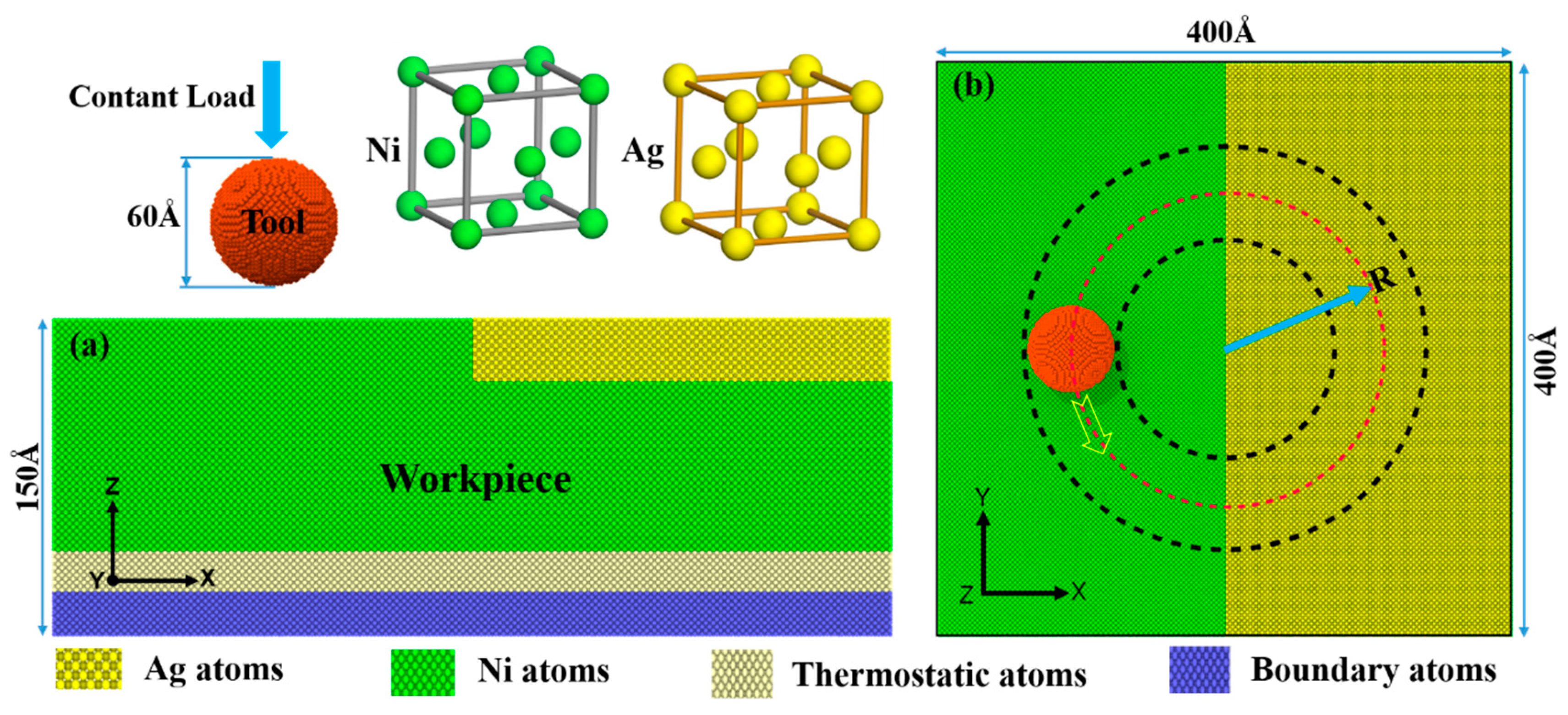
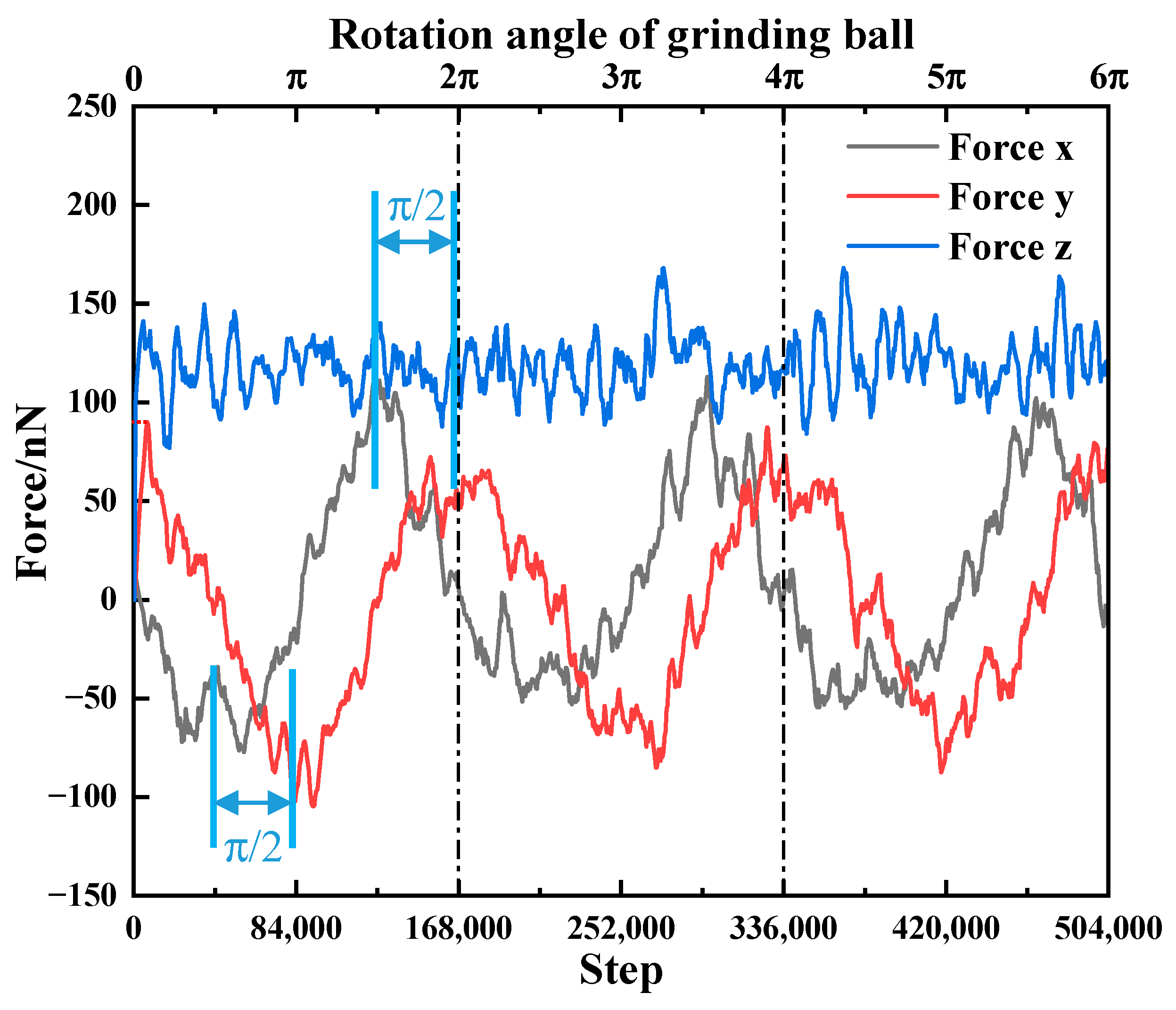
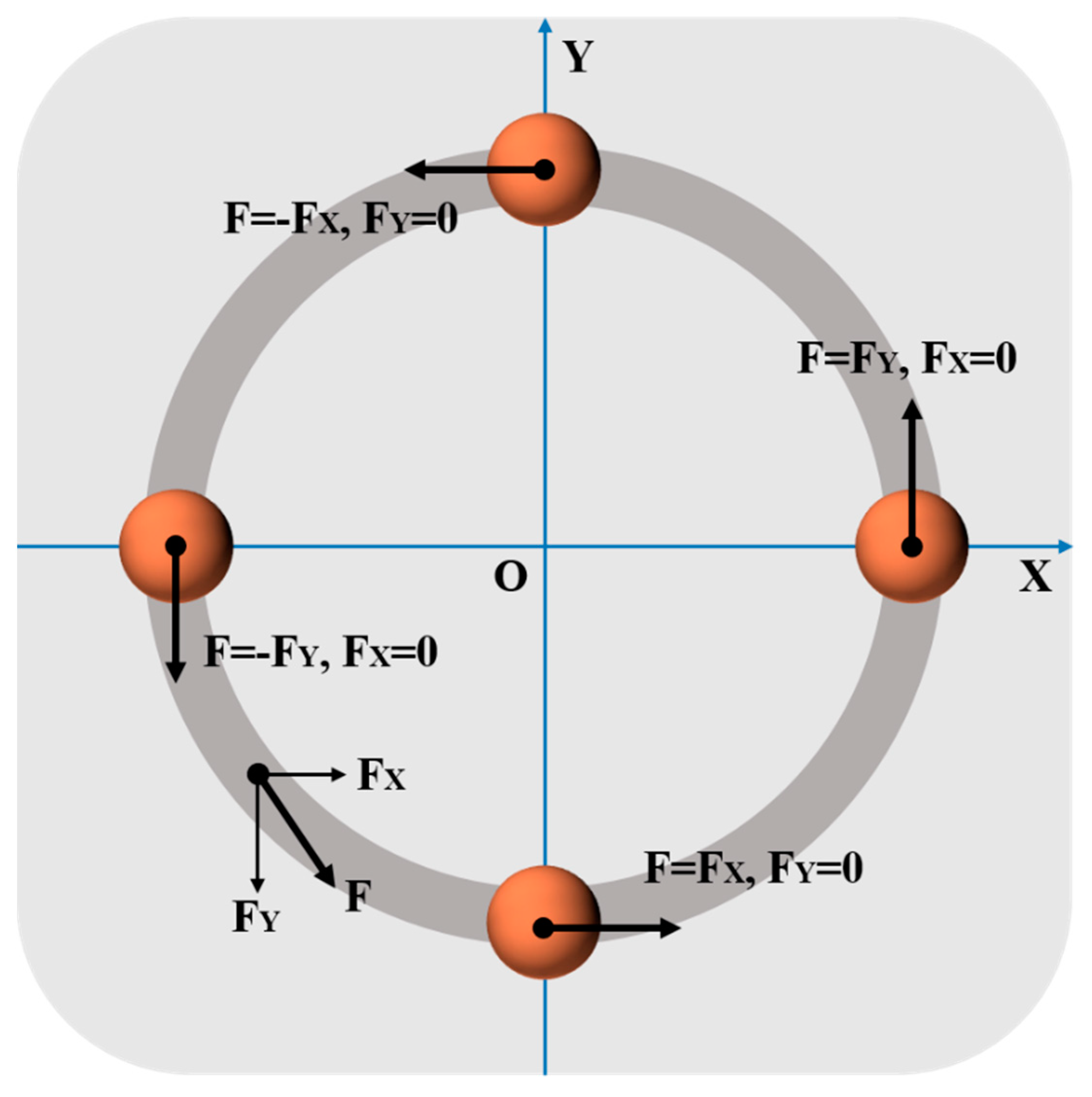

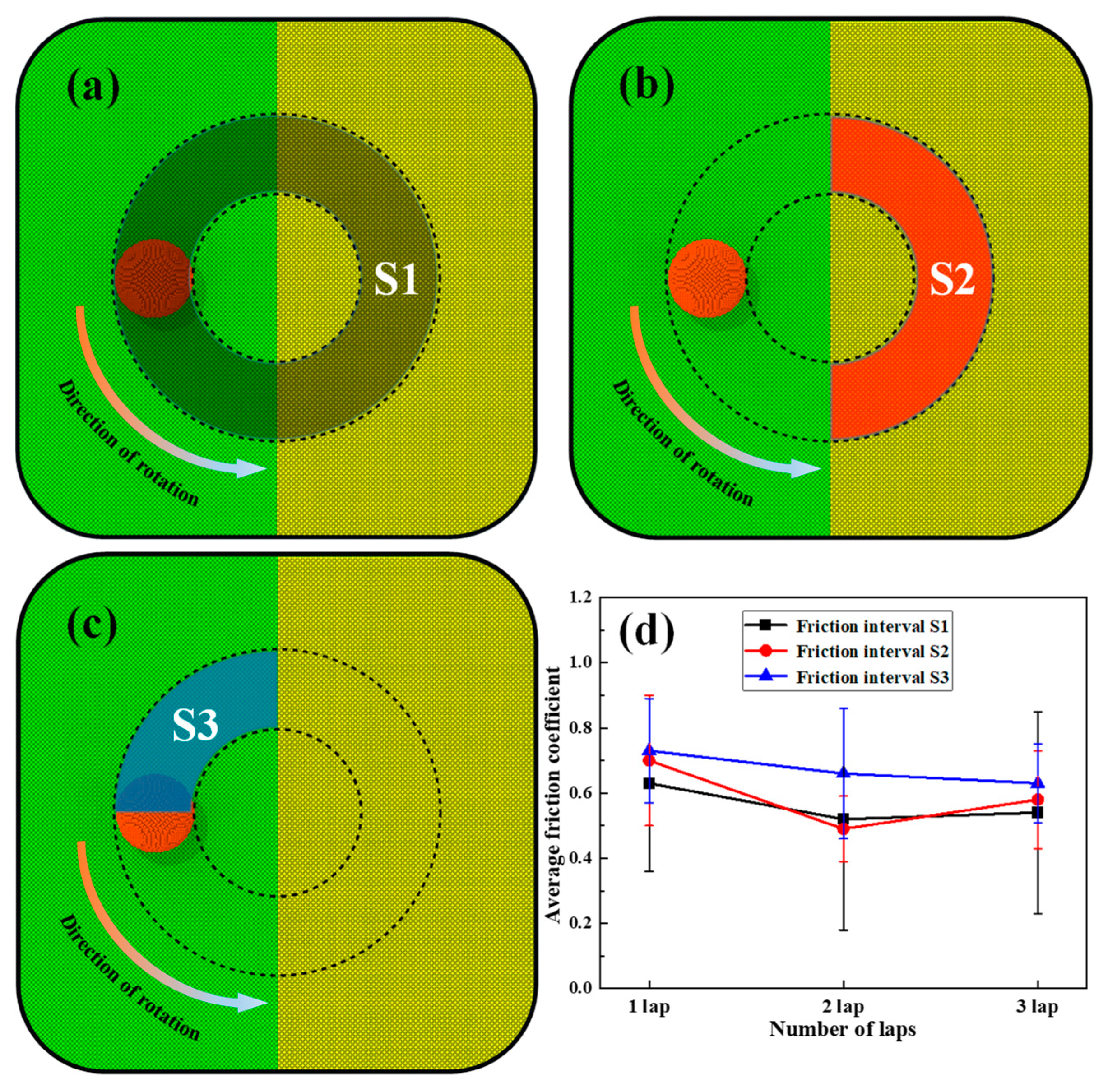

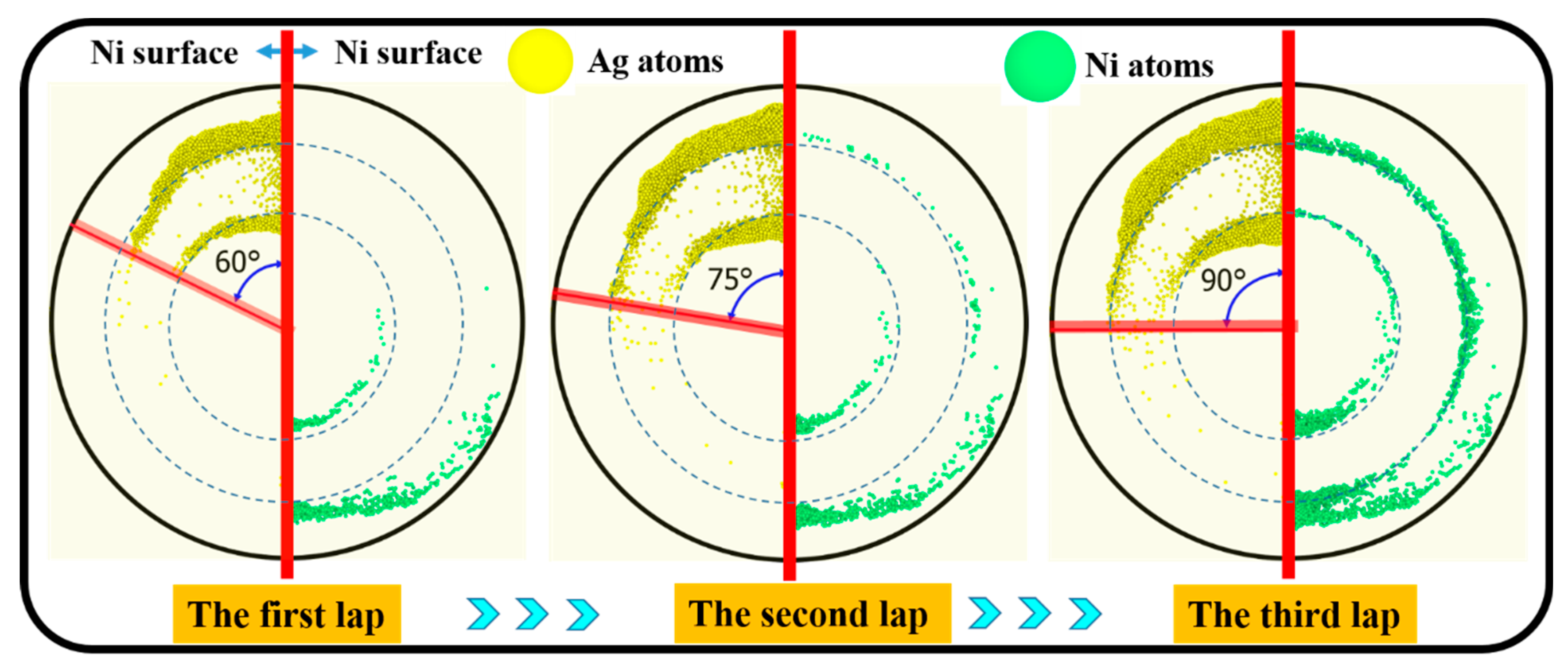
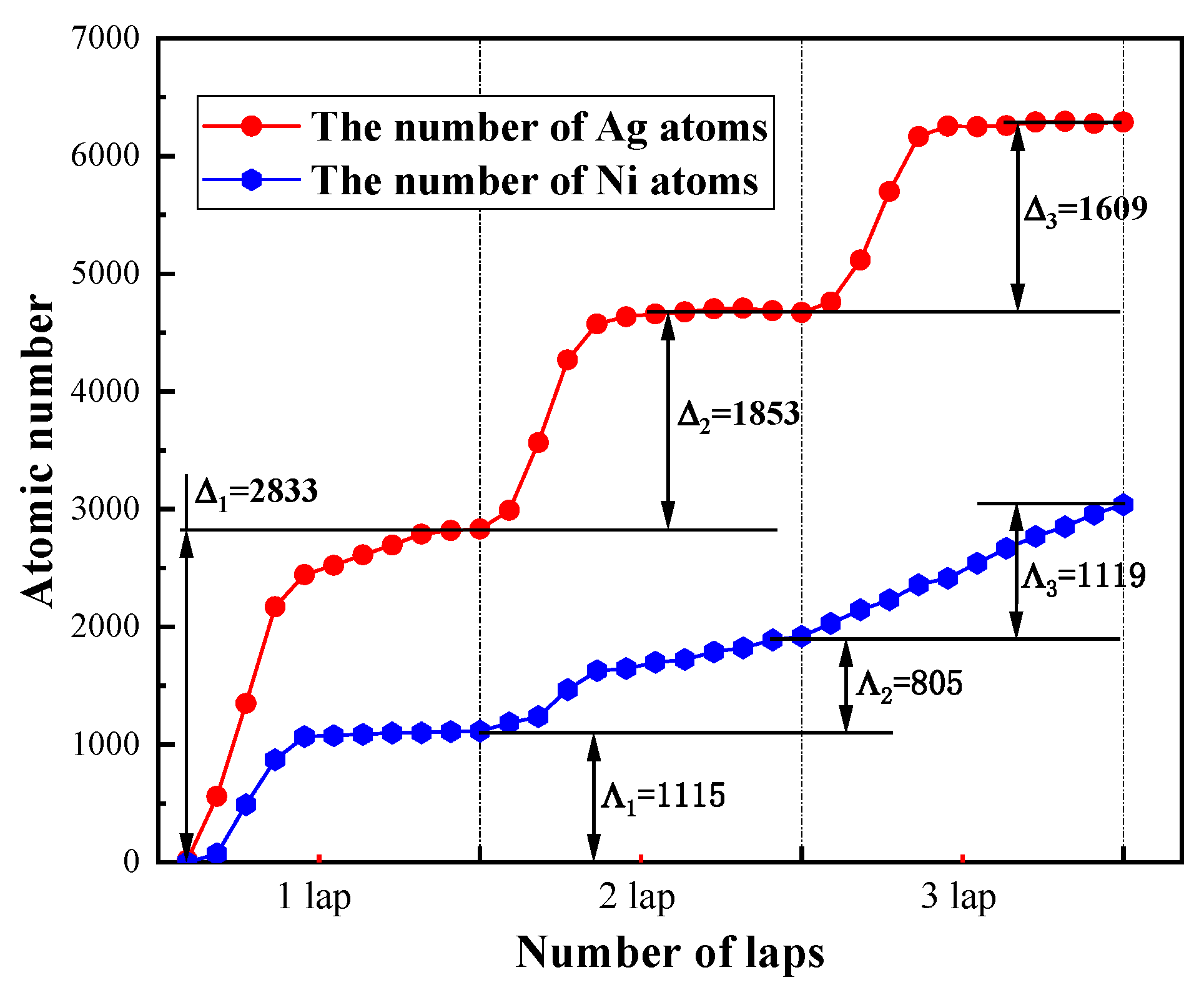

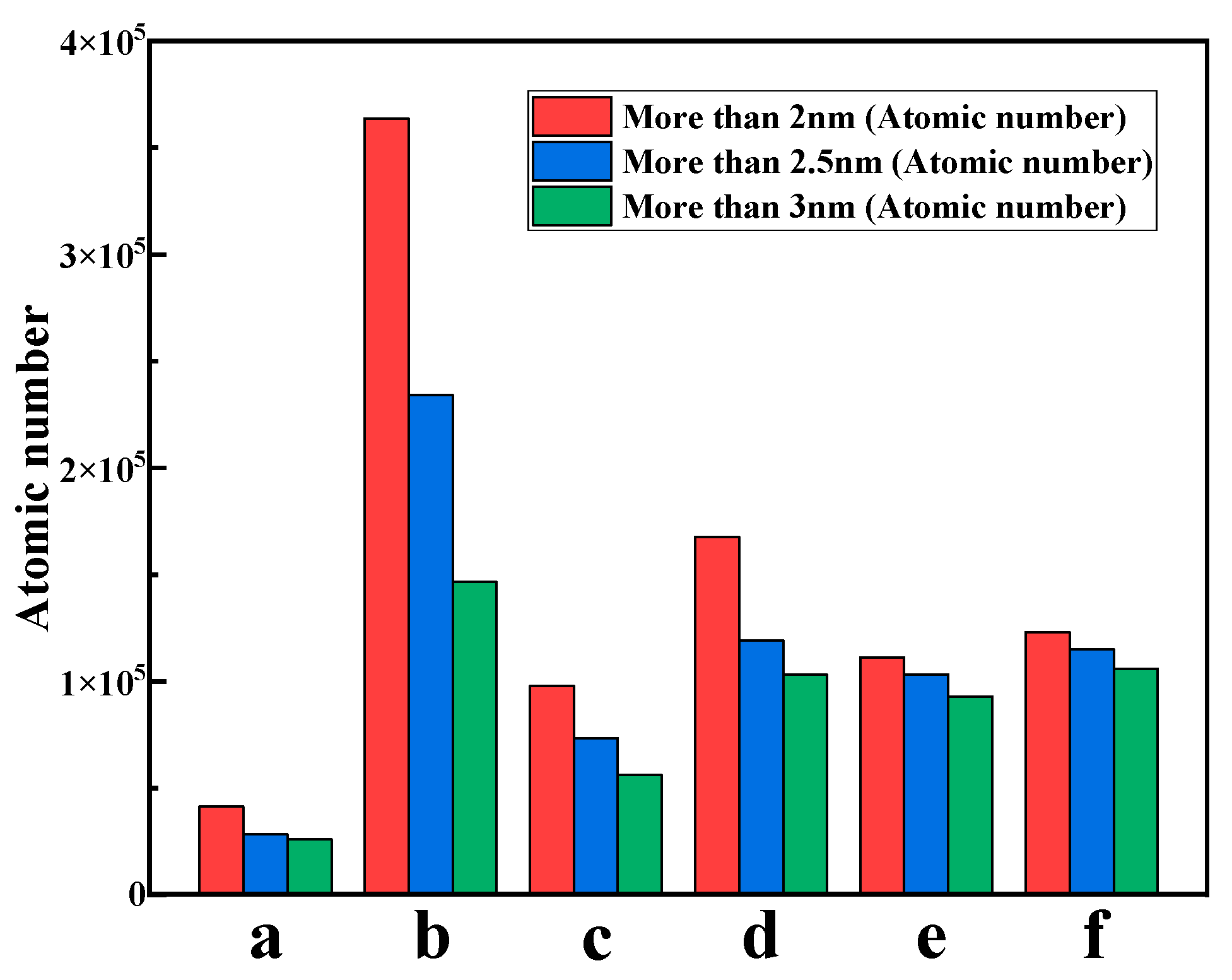


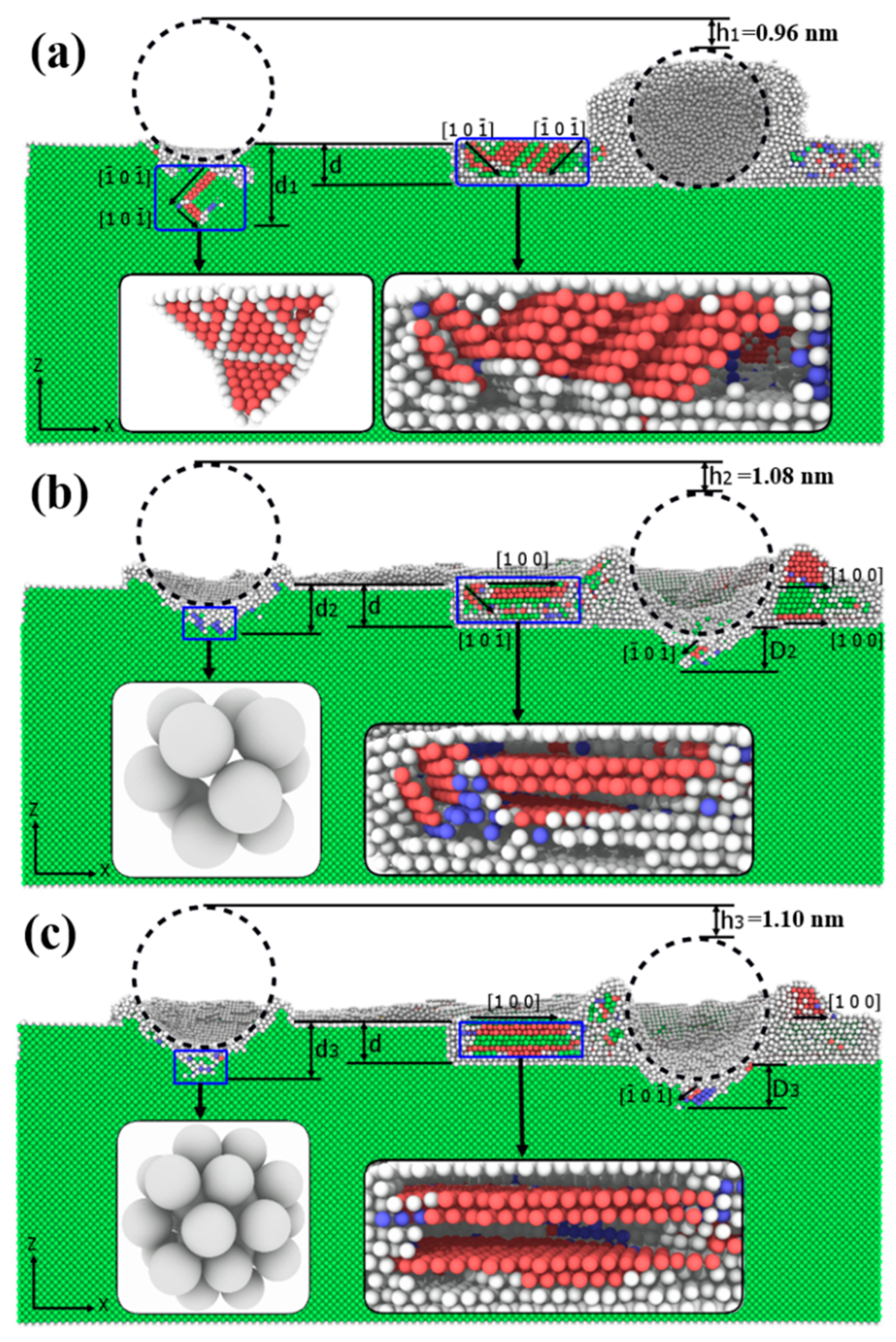
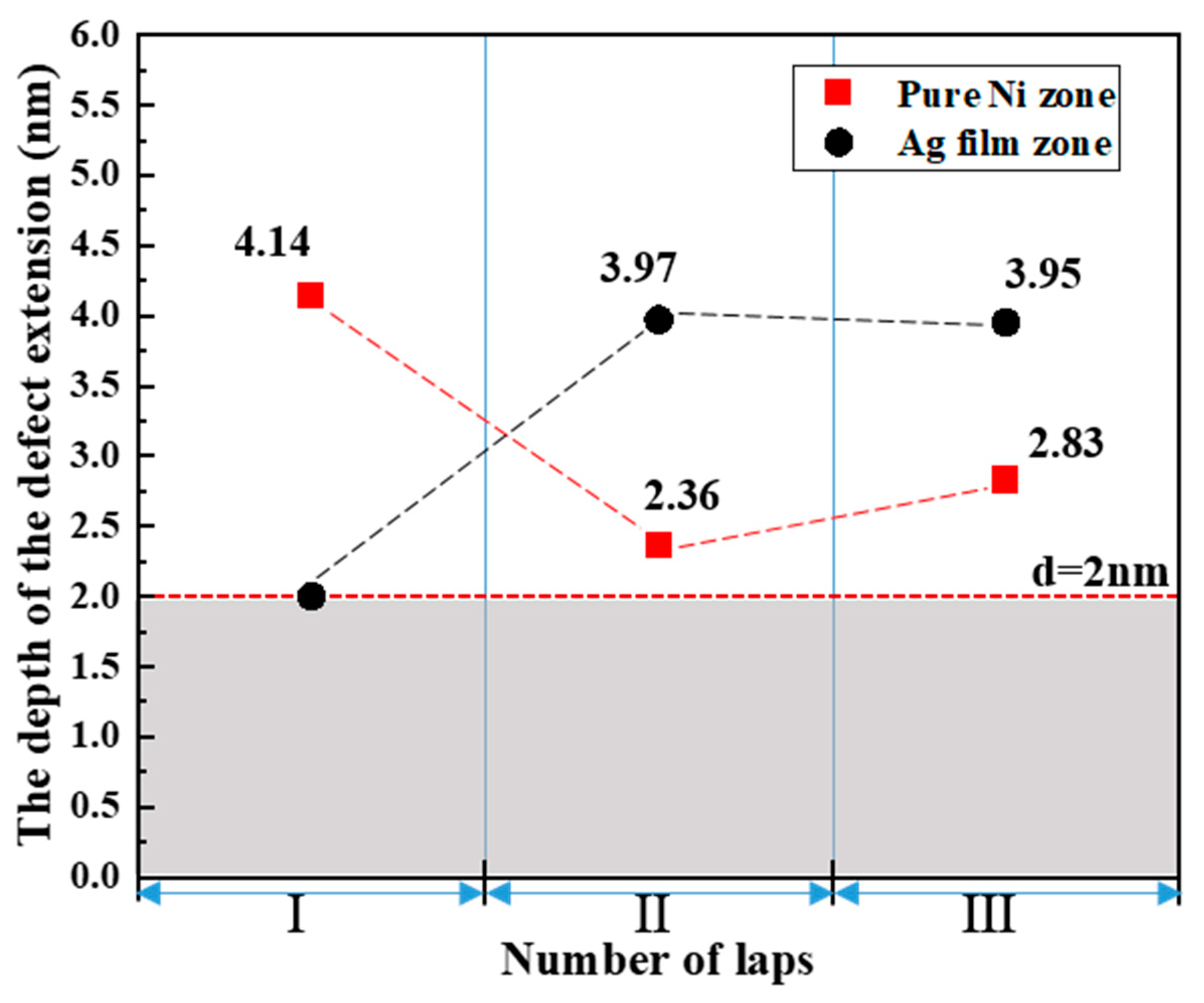


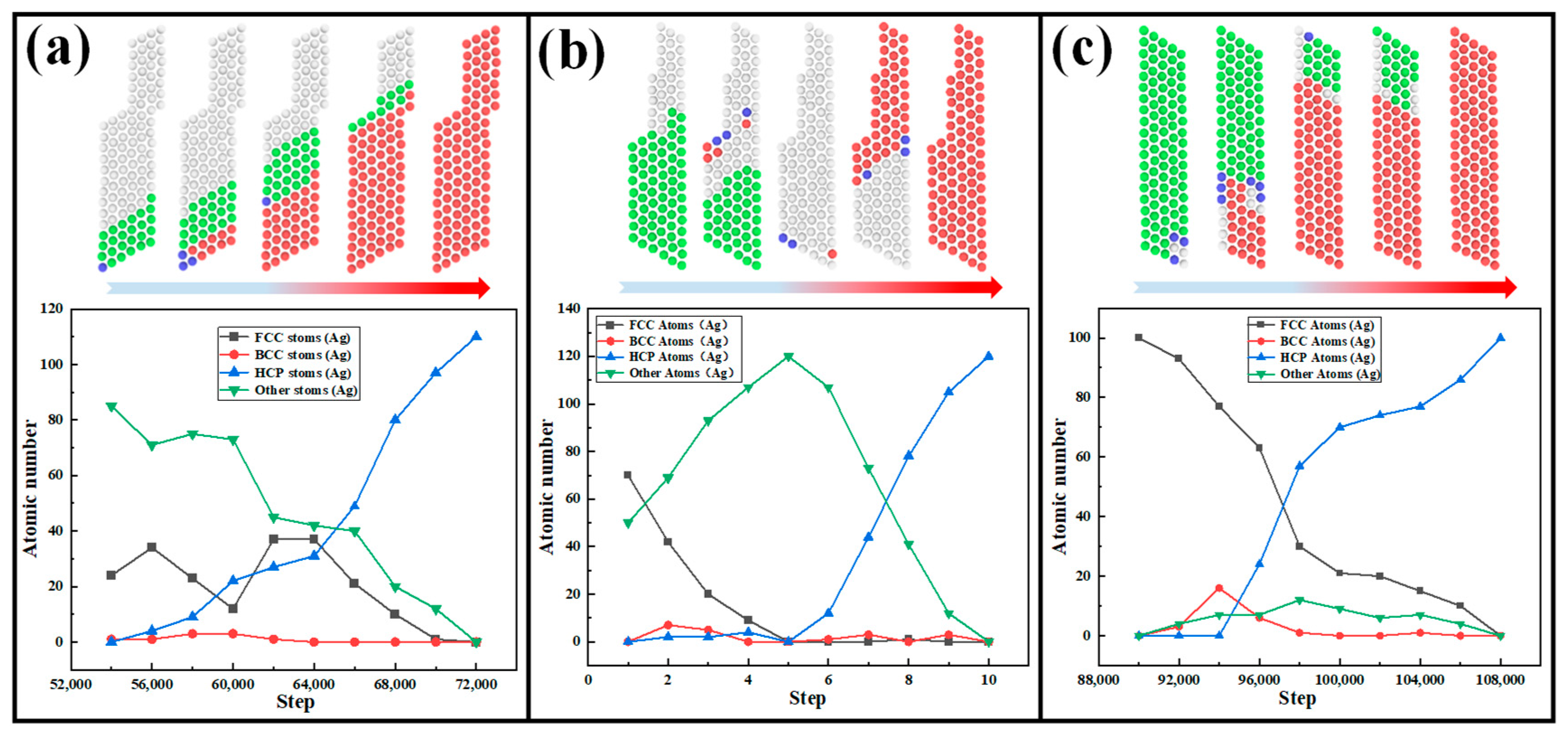

| Materials | Workpiece | Tool: Diamond |
|---|---|---|
| Dimensions | Cubic: 400 Å × 400 Å × 150 Å | Spherical: R = 3 nm |
| Atomic number | 2,009,844 | 20,051 |
| Interatomic potential | EAM Morse | Tersoff |
| Time step | 1 fs | |
| Initial temperature | 300 K | |
| Grinding velocity | 200 m/s | |
| Normal load | 60 nN | |
| Grinding radius | 11.67 nm |
| Atomic Type | D0 (eV) | α (Å/1) | r0 (Å) |
|---|---|---|---|
| C-Ni | 0.100 | 2.2 | 2.4 |
| C-Ag | 0.1 | 1.7 | 2.2 |
| Friction Interval | Average Friction Coefficient/(Number of Laps) | ||
|---|---|---|---|
| S1 | 0.63/(1 lap) | 0.52/(2 lap) | 0.54/(3 lap) |
| S2 | 0.70/(1 lap) | 0.49/(2 lap) | 0.58/(3 lap) |
| S3 | 0.73/(1 lap) | 0.66/(2 lap) | 0.63/(3 lap) |
Disclaimer/Publisher’s Note: The statements, opinions and data contained in all publications are solely those of the individual author(s) and contributor(s) and not of MDPI and/or the editor(s). MDPI and/or the editor(s) disclaim responsibility for any injury to people or property resulting from any ideas, methods, instructions or products referred to in the content. |
© 2023 by the authors. Licensee MDPI, Basel, Switzerland. This article is an open access article distributed under the terms and conditions of the Creative Commons Attribution (CC BY) license (https://creativecommons.org/licenses/by/4.0/).
Share and Cite
Chen, W.; Chen, W.; Zhu, Z.; Zheng, M.; Wei, X.; Shi, T.; Qu, D. Study on the Nano-Friction Behavior of Nickel-Based Ag Film Composites Based on Molecular Dynamics. Lubricants 2023, 11, 110. https://doi.org/10.3390/lubricants11030110
Chen W, Chen W, Zhu Z, Zheng M, Wei X, Shi T, Qu D. Study on the Nano-Friction Behavior of Nickel-Based Ag Film Composites Based on Molecular Dynamics. Lubricants. 2023; 11(3):110. https://doi.org/10.3390/lubricants11030110
Chicago/Turabian StyleChen, Wenbang, Weihua Chen, Zongxiao Zhu, Min Zheng, Xingchun Wei, Tianzuo Shi, and Dingfeng Qu. 2023. "Study on the Nano-Friction Behavior of Nickel-Based Ag Film Composites Based on Molecular Dynamics" Lubricants 11, no. 3: 110. https://doi.org/10.3390/lubricants11030110
APA StyleChen, W., Chen, W., Zhu, Z., Zheng, M., Wei, X., Shi, T., & Qu, D. (2023). Study on the Nano-Friction Behavior of Nickel-Based Ag Film Composites Based on Molecular Dynamics. Lubricants, 11(3), 110. https://doi.org/10.3390/lubricants11030110





